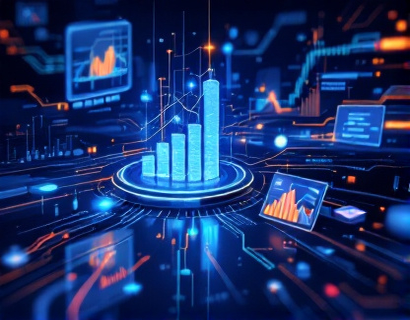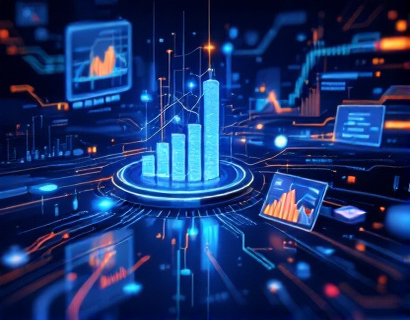Advanced Analytics Transforming Business Insights: Unleashing Growth with Intelligent Data Visualization
In the rapidly evolving landscape of business, the ability to harness and interpret vast amounts of data has become a critical factor for success. Advanced analytics, coupled with intelligent data visualization, is revolutionizing the way organizations make decisions and drive growth. This transformation is not just about managing data more efficiently but about turning complex information into actionable insights that can propel businesses forward. The integration of advanced business intelligence dashboards is at the forefront of this change, offering a powerful toolset for converting raw data into meaningful visual representations that enhance understanding and facilitate informed decision-making.
The Evolution of Business Intelligence Dashboards
The concept of business intelligence dashboards has evolved significantly over the years. Initially, these dashboards were rudimentary, displaying basic metrics and KPIs in a static format. However, with advancements in technology and the increasing volume of data generated by businesses, there was a pressing need for more sophisticated tools. Modern business intelligence dashboards are now dynamic, interactive, and capable of handling large datasets in real-time. These advancements have made it possible for organizations to gain deeper insights into their operations, customer behavior, and market trends, thereby enabling more strategic and data-driven decision-making.
Key Features of Advanced Business Intelligence Dashboards
Advanced business intelligence dashboards come equipped with a range of features that set them apart from traditional reporting tools. One of the most significant advantages is their ability to integrate data from multiple sources seamlessly. This integration allows for a comprehensive view of the business, breaking down silos and providing a unified perspective. Interactive elements such as drill-down capabilities, filters, and real-time updates empower users to explore data in detail and respond to changing conditions swiftly.
Another crucial feature is the use of advanced visualization techniques. Gone are the days of static charts and graphs. Modern dashboards utilize sophisticated visualization methods like heat maps, treemaps, and network diagrams to represent complex data in an intuitive and engaging manner. These visualizations not only make data more accessible but also help in identifying patterns and trends that might go unnoticed in raw data.
Real-Time Data and Predictive Analytics
Real-time data is a game-changer in the realm of business intelligence. With the ability to process and display data as it happens, organizations can monitor operations, customer interactions, and market dynamics in real-time. This immediacy is invaluable for identifying issues promptly and taking corrective actions. Predictive analytics, a subset of advanced analytics, takes this a step further by using historical data to forecast future trends and behaviors. By incorporating machine learning algorithms, predictive analytics can provide insights into potential outcomes, helping businesses prepare for future scenarios and make proactive decisions.
Enhancing Operational Efficiency
The impact of advanced business intelligence dashboards extends beyond strategic decision-making to operational efficiency. By providing a centralized platform for data management, these dashboards streamline workflows and reduce the time spent on data collection and analysis. Automated reporting and alert systems ensure that critical information is communicated promptly to the right stakeholders, minimizing delays and improving response times. This efficiency translates into cost savings and a more agile organization capable of adapting to market changes quickly.
Moreover, advanced dashboards can integrate with various business processes, such as supply chain management, customer relationship management, and financial planning. This integration allows for a holistic view of operations, enabling managers to identify bottlenecks, optimize resource allocation, and enhance overall productivity. For instance, in supply chain management, real-time visibility into inventory levels, shipping statuses, and supplier performance can help in making informed decisions to prevent stockouts or excess inventory.
Driving Strategic Growth
Strategic growth is inherently linked to data-driven insights. Advanced business intelligence dashboards empower organizations to uncover hidden opportunities and mitigate risks by providing a deep understanding of internal and external factors. For example, market analysis dashboards can track competitor activities, consumer preferences, and economic indicators, allowing businesses to adjust their strategies accordingly. This proactive approach ensures that organizations stay ahead of the curve and capitalize on emerging trends.
Customization is another key aspect that enhances the strategic value of these dashboards. Organizations can tailor dashboards to meet their specific needs, focusing on the metrics and KPIs that matter most to their business. This flexibility ensures that the insights generated are relevant and actionable, driving targeted initiatives that align with the organization's goals. Whether it's improving customer satisfaction, increasing sales, or optimizing operational costs, advanced analytics provides the necessary tools to achieve these objectives.
Case Studies and Success Stories
Numerous organizations across various industries have successfully leveraged advanced business intelligence dashboards to transform their operations and drive growth. In the retail sector, a major e-commerce company implemented a comprehensive dashboard that integrated data from sales, marketing, and logistics. This integration provided real-time insights into customer behavior and inventory levels, leading to more accurate demand forecasting and reduced stock discrepancies. As a result, the company saw a significant increase in sales and a decrease in operational costs.
In the manufacturing industry, a leading automotive manufacturer adopted an advanced analytics platform to monitor production lines and supply chain activities. The dashboard's predictive capabilities helped in identifying potential equipment failures before they occurred, reducing downtime and maintenance costs. Additionally, real-time visibility into production metrics allowed for timely adjustments, optimizing output and quality. These improvements contributed to a substantial increase in productivity and customer satisfaction.
Challenges and Considerations
While the benefits of advanced business intelligence dashboards are clear, organizations must also be aware of the challenges and considerations involved in their implementation. One of the primary challenges is data quality. Inaccurate or incomplete data can lead to misleading insights, undermining the effectiveness of the dashboard. Therefore, ensuring data integrity through robust data governance practices is essential.
Another consideration is the need for skilled personnel to manage and interpret the data. While dashboards can automate many processes, human expertise is still crucial for contextualizing the insights and making strategic decisions. Organizations should invest in training and developing the skills of their data analytics teams to fully leverage the potential of advanced dashboards.
Technological infrastructure is another critical factor. Implementing advanced business intelligence solutions requires a solid IT foundation, including high-performance computing resources and secure data storage. Organizations must assess their current infrastructure and plan for upgrades or enhancements to support these sophisticated tools.
Future Trends in Business Intelligence
The landscape of business intelligence is continually evolving, with several trends poised to shape the future of advanced analytics and data visualization. One such trend is the increasing adoption of artificial intelligence (AI) and machine learning (ML) in dashboards. AI-driven analytics can automate complex data processing tasks, uncover deeper insights, and provide more accurate predictions. For instance, natural language processing (NLP) can enable users to interact with dashboards using natural language queries, making data exploration more intuitive.
Another trend is the rise of cloud-based business intelligence solutions. Cloud platforms offer scalability, flexibility, and cost-effectiveness, allowing organizations to access powerful analytics tools without the need for extensive on-premises infrastructure. This shift to the cloud also facilitates collaboration, as multiple users can access and contribute to dashboards from anywhere, enhancing teamwork and decision-making processes.
Furthermore, the integration of Internet of Things (IoT) data into business intelligence dashboards is becoming more prevalent. IoT devices generate vast amounts of real-time data that can provide valuable insights into operational processes, equipment performance, and customer interactions. By incorporating IoT data, organizations can gain a more comprehensive view of their operations and make more informed decisions.
Conclusion
Advanced business intelligence dashboards are more than just tools for data visualization; they are transformative platforms that empower organizations to unlock the full potential of their data. By converting complex information into actionable insights, these dashboards streamline decision-making, enhance operational efficiency, and drive strategic growth. As businesses continue to generate and accumulate data at an unprecedented pace, the ability to harness and interpret this data effectively will remain a key differentiator in the competitive landscape. Embracing advanced analytics and intelligent data visualization is not just an option but a necessity for organizations aiming to thrive in the digital age.










































